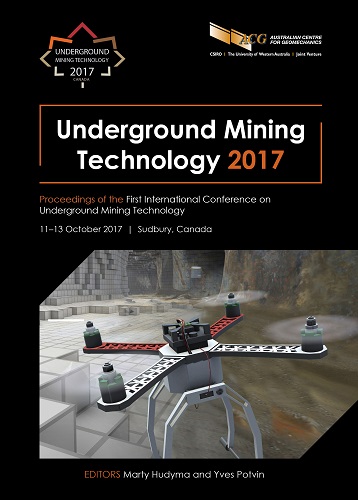Evaluation of the optimum conditions for a local ventilation system in connection with the mine ventilation network

|
Authors: Lee, D-K |
DOI https://doi.org/10.36487/ACG_rep/1710_55_Lee
Cite As:
Lee, D-K 2017, 'Evaluation of the optimum conditions for a local ventilation system in connection with the mine ventilation network', in M Hudyma & Y Potvin (eds), UMT 2017: Proceedings of the First International Conference on Underground Mining Technology, Australian Centre for Geomechanics, Perth, pp. 655-661, https://doi.org/10.36487/ACG_rep/1710_55_Lee
Abstract:
In a single working face in an underground mine, a single duct and a booster fan are installed to provide fresh air to the working face for local ventilation. Since this local ventilation is provided in conjunction with the entire ventilation network of the mine, its performance and resulting environment depend on the conditions of air intake and exhaust, the duct leakage, and the fan characteristics. To operate an effective ventilation system, the optimal ventilation conditions should be identified along with the characteristics of the mine development. In this study, a computational analysis was conducted considering the ventilation method, conditions of the duct and the fan for a selected test mine scenario to provide an effective and economical local ventilation system. The resulting optimum local ventilation conditions suggested were based on an evaluation of these characteristics.
Keywords: mine ventilation, numerical modelling, auxiliary ventilation, duct
References:
Calizaya, F & Mousset-Jones, P 1997, ‘Estimation of leakage quantity for long auxiliary ventilation systems’, in RV Ramani (ed.) Proceedings of the 6th International Mine Ventilation Congress, Society for Mining, Metallurgy, and Exploration, Littleton, pp. 475–478.
Lee, DK 2011, ‘A computational flow analysis for choosing the diameter and position of an air duct in a working face’, Journal of Mining Science, vol. 47, no. 5, pp. 664–674.
McPherson, MJ 1993, Subsurface Ventilation and Environmental Engineering, Chapman & Hall, London.
Millar, D, Levesque, M & Hardcastle, S 2017, ‘Leakage and air flow resistance in mine auxiliary ventilation ducts: effects on system performance and cost’, Transactions of the Institutions of Mining and Metallurgy: Section A, vol. 126, no. 1, pp. 10–21.
Mirakovski, DG & Krstev, B 2000, ‘Design process and equipment selection for auxiliary ventilation systems’, in GN Panagiotou & TN Michalakopoulos (eds), Proceedings of the Ninth International Symposium on Mine Planning and Equipment Selection, A.A. Balkema, Rotterdam, pp. 89–93.
Onder, M 2002, ‘Selection of fan or fan location in ventilation of long drivages and the effect of recirculation on fan number’, in GN Panagiotou & TN Michalakopoulos (eds), Proceedings of the Ninth International Symposium on Mine Planning and Equipment Selection, A.A. Balkema, Rotterdam, pp. 105–110.
Tuck, M & Naser, J 2005, ‘A three-dimensional simulation of mine ventilation using computational fluid dynamics’, in DS Gillies (ed.), Proceedings of the 8th International Mine Ventilation Congress, Australasian Institute of Mining and Metallurgy, Melbourne, pp. 489–491.
Vutukuri, VS 1984, ‘Design of auxiliary ventilation systems for long drivages’, Proceedings of the Fifth Australian Tunneling Conference, Institution of Engineers, Sydney, pp. 73–79.
Vutukuri, VS 1987, ‘Design of auxiliary ventilation systems for long drivages’, Transactions of the Institution of Engineers, CE29.
© Copyright 2025, Australian Centre for Geomechanics (ACG), The University of Western Australia. All rights reserved.
View copyright/legal information
Please direct any queries or error reports to repository-acg@uwa.edu.au
View copyright/legal information
Please direct any queries or error reports to repository-acg@uwa.edu.au